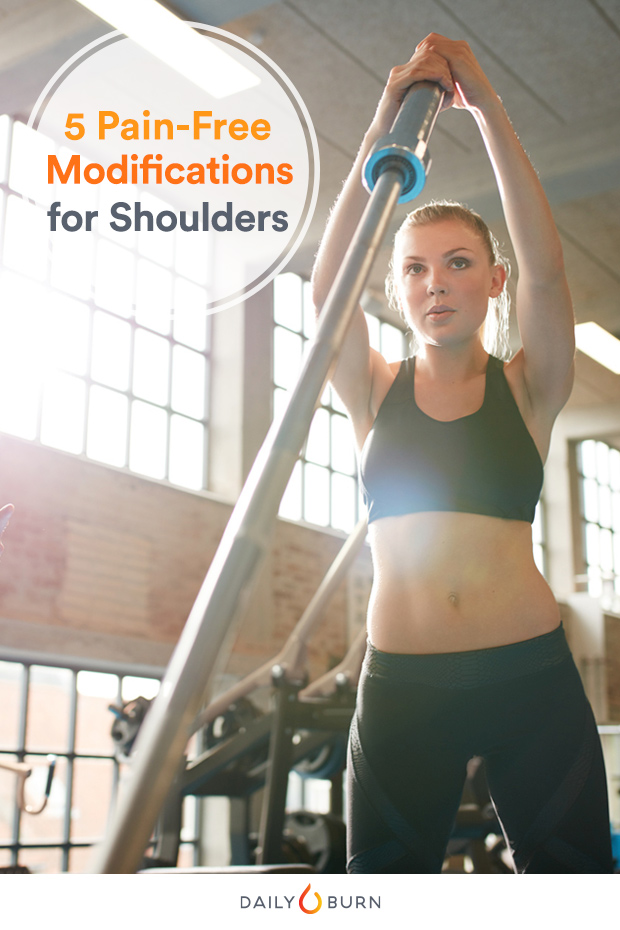
Everything’s a trade-off. So, while the shoulder joint enjoys its title as the most mobile joint in the human body, it’s unfortunately also the least stable, and most easily injured, joint in the human body.
“The shoulder, which actually comprises four separate joint structures, is a really complex joint, and involves a lot of moving parts that, if not all working together properly, can result in impingement, pain and fraying of muscles and tendons,” explains exercise physiologist Matt Unthank, CSCS, director of training for Crossover Symmetry. Hence why you should never just “suck it up” and push through shoulder pain.
But, if you’ve got shoulder pain, swearing off any and all shoulder exercises isn’t the answer either, Unthank says. After all, you’ve got to work the joints if you’re going to strengthen them and get them healthy (and pain-free) again.
So how do you strengthen your shoulders without wanting to curse through every rep? We talked to leading experts to ID five easy modifications to help eliminate pain during common shoulder moves.
5 Exercise Tweaks to Reduce Shoulder Pain
1. The Move: Shoulder Press
How to Modify It: The shoulder is at its most vulnerable in the overhead position, and if you have any dysfunction within the joint, the muscles that connect to your shoulder blade can jam against the acromion process, a bony protrusion at the side of the shoulder. (If you feel around the meaty portion of your shoulder, you might feel it poke you.) To avoid this impingement, perform shoulder presses with a landmine, rather than a dumbbell or barbell.
If you haven’t used the landmine at your gym yet, it’s the barbell that’s attached at one end to the floor. Standing tall with your feet shoulder-width apart, grab the free end of the landmine with both hands at chest height, and press the weight up and away from you, Unthank says.
2. The Move: Front Shoulder Raise
How to Modify It: When performing front shoulder raises, many people lift the dumbbells far above their shoulders, which is where most impingements happen, explains kinesiologist and medical exercise specialist Dean Somerset, CSCS. Luckily, you don’t have to hoist the weights clear up to eye level to really develop your anterior deltoids. “Reduce your range of motion and stop each rep with the weights at shoulder height or just below shoulder height,” Somerset says. If that doesn’t do the trick, you can also try performing each raise with your palms facing each other, rather than the floor, he says.
3. The Move: Bench Press
How to Modify It: The bench press is most likely to give you problems if you don’t keep your shoulder blades fixed throughout the entire movement — which most people don’t even know to do, Somerset says. Here’s how it works: Lie down on a bench and, holding your weight(s) above your chest, pull your shoulder blades down and back, almost as if you are trying to squeeze an orange between them. Now, perform your bench press as normal, keeping your shoulder blades in this retracted position the entire time, he says. Avoid the temptation to flare your shoulder blades at the top of the movement.
If you still have problems, you can also try performing a push-up rather than a bench press, says exercise physiologist Pete McCall, MS, CSCS. Because push-ups keep the hands completely fixed, they introduce less instability to the shoulder. Bonus: The pressure of your hands against the floor (really “dig” your fingers into it!) helps to activate the rotator cuff muscles and further improve stability, McCall says.
4. The Move: Lateral Shoulder Raise
How to Modify It: Instead of lifting the weights straight out to your sides (at 9 o’clock and 3 o’clock), lift them diagonally in front of you (at 10 o’clock and 2 o’clock), McCall says. That angle allows your humerus (upper arm bone) to follow a more natural movement path within the shoulder joint, thereby lowering the risk of any irritation, he says.
5. The Move: Rear-Delt Fly
How to Modify It: Usually performed with dumbbells, you can also complete this exercise on a pec deck machine to reduce instability and the risk of pain, McCall says. To do so, sit at the pec deck machine, legs straddling the bench and stomach pressed firmly against the backrest. From here, you can complete the exercise per usual. However, since the machine keeps the weight fixed, it’ll be easier to perform the exercise with good form and train your rotator cuff muscles to fire properly, he says. As you get stronger at this exercise, you can try introducing free weights again.
Originally written for DailyBurn.com